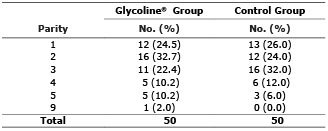
ORIGINAL
The effect of Glycoline® on reproductive efficiency in high-producing dairy cows
Efecto del Glycoline® sobre la eficiencia reproductiva en vacas lecheras de alta producción
Marcelo Del Campo,1* Ph.D, Marco Gonzalez T,2 M.Sc, Hans Andresen,3 M.Sc, Freddy A. Cea,1 M.Sc.
1Universidad Santo Tomás, Faculty of Natural Resources and Veterinary Medicine, Temuco, Chile.
2Universidad de Córdoba, Faculty of Veterinary and Zootechnical Medicine, Department of Livestock Sciences, Tropical Biology Research Institute, Montería, Colombia.
3Universidad Nacional Mayor de San Marcos, Lima, Peru.
*Correspondence: mrdelcampo@yahoo.es
Received: March 2015; Accepted: November 2015.
ABSTRACT
Objective. Determine the effect of Glycoline® on reproductive efficiency in high producing dairy cows. Materials and methods. 100 Holstein cows one month before delivery were selected. About 21 days before delivery they were put in a stable and were randomized in two groups: Glycoline® Group (GG, n = 50), 300 g/day of Glycoline® for 21 days antepartum and 250 g/day of GlycoLine® over the following 21 days postpartum, and the Control Group (CG, n = 50) with the same feed and silage ration as GG during the same period, but without the addition of Glycoline®. Events and reproductive variables of the cows were recorded for 202 days. The data were systematized, analyzed and statistically compared. Results. Comparisons were made between GG and CG respectively: Retained placenta (0.0 vs. 12.0%; p=0.027), falling cow disease (14.3 vs. 44.0%; p=0.002), uterine involution (64.6 vs. 36.4%; p=0.019 ), uterine infection (10.4% vs. 35.5%; p=0.006), lack of ovarian activity (6.3 vs. 25.6%; p=0.018), follicular cysts (0.0 vs. 18.2%, p = 0.002), luteal structures (25.0 vs. 9.3% ; p=0.058), mean estrus presentation (40.1% vs. 63.5%; p=0.033) inseminated females (79.6 vs. 68.0%; p=0.017), pregnancy rate at day 295 (57.1 vs. 46.0%; p≥0.317 ) and periods (days): 1st heat after delivery (39.8 vs. 63.2; p≤0.006), IA delivery (62.4 vs. 87.5; p≤0.006) pregnancy-delivery (81.7 vs. 93.6; p≤0.006; p=0.103). Conclusions. Results suggest that dietary Glycoline® added in the transition period improves reproductive efficiency of high-producing cows.
Key words: Nutritional supplements, reproductive health, reproductive performance, reproductive physiology, reproductive stages (Source: CAB).
RESUMEN
Objetivo. Determinar el efecto del Glycoline® sobre la eficiencia reproductiva en vacas lecheras de alta producción. Materiales y Métodos. Se seleccionaron 100 vacas Holstein un mes antes del parto. Alrededor de 21 días antes del parto se ubicaron en un establo y se asignaron al azar a dos Grupos: Grupo Glycoline® (GG; n=50), 300 g/día de Glycoline® durante 21 días preparto y 250 g/día de Glycoline® durante los siguientes 21 días posparto y Grupo Control (GC, n=50) la misma ración de concentrado y ensilaje que el GG durante el mismo período de tiempo, pero sin la adición de Glycoline®. Se registraron los eventos y las variables reproductivas de las vacas durante 202 días. Los datos fueron sistematizados, analizados y comparados estadísticamente. Resultados. Comparaciones entre el GG y GC respectivamente: Retención de placenta (0,0 vs 12.0%; p=0.027), síndrome de vaca caída (14.3 vs 44.0%; p=0.002), involución uterina (64.6 vs 36.4%; p=0.019), infección uterina (10.4% vs 35.5%; p=0.006), sin actividad ovárica (6.3 vs 25.6%; p=0.018), quistes foliculares (0.0 vs 18.2%, p=0.002), estructuras luteales (25.0 vs 9.3%; p=0.058), promedio presentación de celo (40.1% vs 63.5%; p=0.033), hembras inseminadas (79.6 vs 68.0%; p=0.017), tasa de preñez al día 295 (57.1 vs 46.0%; p≥0.317) y lapsos (días): parto 1er celo (39.8 vs 63.2; p≤0.006), parto IA (62.4 vs 87.5; p≤0.006) y parto-preñez (81.7 vs 93.6; p≤0.006; p=0.103). Conclusiones. Los resultados sugieren que el Glycoline® adicionado en la dieta en el período de transición, mejora la eficiencia reproductiva de vacas de alta producción.
Palabras clave: Desempeño reproductivo, estados reproductivos fisiología reproductiva, salud reproductiva, suplementos nutricionales (Fuente: CAB).
INTRODUCTION
Reproductive efficiency of cows can be assessed by taking into account different parameters. The producer would perhaps consider an efficient reproductive herd to be one in which each female produces a calf before 24-25 months of age and continues to produce a calf each year. However, to produce an annual calf per cow a series of coordinated physiological events must occur within the body of a cow (1).
It is common knowledge that selecting cows for high milk production negatively influences reproductive efficiency. The negative effect attributed to high milk production on reproduction is related to a number of causes and factors that contribute to low fertility. Among these, some are due to the cow’s environment (management, untrained staff, size of herds, confinement etc.) and others depend on the cow itself (body condition, negative energy balance), increase dry matter intake, increased hepatic irrigation and steroid metabolism (1-3). However, in theory high producing cows should not have greater reproductive problems since they are prepared for this state.
The causes that most affect cows occur during the critical transition period (three weeks antepartum and 3 weeks postpartum). In this period the pregnant cow is subject to increased requirements by the fetus, the stress of labor and later due to high milk production.
Moreover, after delivery, milk production increases faster than food consumption, exposing cows to a negative energy balance (NEB). All these factors predispose cows to metabolic diseases (ketosis, hypocalcaemia, etc.) and infections (metritis, mastitis) luteal or follicular cysts or anestrus, among others (4). These negatively affect cows at any reproductive stage from conception to pregnancy.
The condition of a “reproductively healthy cow” has been described as a cow that reduce the time of uterine involution with the concurrent early resumption of postpartum ovarian activity and contribute to regulating the estrous cycle and ovulation (5). For this to happen, the cow’s body must adapt to dramatic metabolic and hormonal changes within very short periods of time.
It is estimated that half of the reasons of culling dairy farms is due to an unbalanced diet, which ultimately results in high operating costs. In some countries cows calve 2.5 times or less during their reproductive lives and in many cases they are, on average, culled after the second parturition. Also, raising replacement heifers has a high value and it takes about 1.5 lactation periods to cover those costs (6).
According to literature, Glycoline® is a glucogenic supplement, offered on the market as an anticetosic that is preferably added to the diet during the transition period. However, the indirect effect it would have on postpartum reproduction (fertility) has not been studied. Similar studies on other glucogenic products have been directed to elucidate their effect on milk production, hormone levels and some metabolic profiles.
The aim of this study was to determine the effect of adding dietary Glycoline® during the transition period on the reproductive efficiency of high producing dairy cows.
MATERIALS AND METHODS
Farm. The study was conducted on a dairy farm that kept an average 170±20 Holstein Friesian cows in annual production, free of tuberculosis and brucellosis, with an average annual milk production of 10.000±1.800Kg/cow. The herd had a prior history of metabolic diseases such as ketosis, hypocalcemia and hypomagnesaemia.
Management and selection of animals. Cows were milked 2 or 3 times a day according to their individual production. Feed consisted of pasture ryegrass (Lollium anual) and a thoroughly mixed ration (TMR) feeding system. At the eighth month of gestation, cows that had a body condition between ≥2.5 and ≤4.0 (1-5 scale) and showed no physical disorder or disease were selected (Table 1).
Table 1. Distribution of cows according to parity.

The average calving for selected cows (2.5 births) was approximately the same for both groups.
Treatment allocation. Before completing 21 days before delivery (280 days gestation) cows were located in a barn with optimum handling and comfort and were randomized into two groups: Glycoline® Group (GG, n=50), Glycoline® 300 g/day for 21 days prepartum, and Glycoline® 250 g/day for the next 21 days postpartum, and the Control Group (CG, n=50) received the same feed and silage as GG for the same period but without adding Glycoline®. The daily Glycoline® dose was mixed with grass silage, oat straw (2.5 kg) and feed (9.0 kg) in a mechanical mixer.
Feed was distributed between 8:00 and 9.00 h and was based on the number of cows housed at that time. Cows were observed during the distribution of feed and for an additional 15 min in order to observe rejection or acceptance.
Thirty-five to 40 days after calving the cows were examined clinically and genitally by the same veterinarian. All those that had no general health problems or genital infections and have ovarian activity were authorized to be inseminated after the waiting period (50 days).
All reproductive events that occurred during the course of this study were recorded (from 30 days before calving). Reproductive data of each female were systematized. To confirm pregnancy, all cows were palpated rectally 40-45 days post-insemination (pIA) and again at 90 and 150 days. Cows that were not pregnant after 2 or 3 inseminations were examined and removed.
The following events were determined and compared between groups.
Prepartum. Feed consumption (subjective observation):
1= eager, ate eagerly and with pleasure
2= semi-eager, partially rejected
3= rejected, did not eat
Parturition birth. Loss before during or immediately after delivery.
1= Abortions
2= Offspring deaths
Calving difficulties and retained fetal membranes (RFM):
1= without difficulty, without or minimal assistance
2= with difficulty, moderate to major assistance
3= removal of the placenta with manual or/and pharmacological assistance.
Cows that retained the placenta ≥24h postpartum were considered to be RMF.
Metabolic diseases:
1= presumed diagnosis, evident symptoms.
2= clinical diagnosis, paresis.
Biochemical profiles were not conducted. Both diagnosis were analyzed together under “downer cow syndrome”
Postpartum:
The state of uterine involution was objectively assessed by rectal examination, on a scale from 1 to 3.
1 = Complete uterine involution: pelvic location, fits in the palm of the hand, or with a slightly greater volume, horns similar in size, without fluctuation, firm consistency and tone. Closed cervix.
2 = Partial uterine involution: abdominal or pelvic location, larger than a palm, horns different in size, palpable but with difficulty, no fluctuation, firm consistency, with moderate tone. Closed cervix.
3 = lack of uterine involution: abdominal location, larger than the palm, horns different in size, not easily touched, with or without fluctuation, flaccid consistency and lacking tone. Cervix open or semi-open.
Genital examination:
1= healthy
2= vaginitis
3= metritis
a= endometritis level 1
b= endometritis level 2
c= pyometra
Ovarian examination and pathologies:
1= Active, with follicles ≥10mm diameter, and/or luteal structures: corpus hemorrhagic (CH) and corpora lutea (CL).
2= Non active, with no palpable structures
3= Cysts: follicular (FC) and luteal (LC)
Postpartum estrus:
They were recorded at fixed and cumulative periods of time (subjective division). Cows were observed 2 times a day (am/pm) by a single operator.
Inseminated and pregnant cows:
1= Services per conception
2= Pregnancy rates during fixed and cumulative periods of time (subjective division).
Time intervals:
1= Birth, calving to first heat
2= Birth, calving to first service
3= Calving to conception (Open days)
Statistical analysis. After compiling the data matrix, an exploratory analysis was conducted. Contingency tables were made to compare groups with their respective Chi squared (χ2) or Fischer Exact Test as necessary. To compare averages the Student t test and the Mann-Whitney U test were used for variables with and without normal distribution.
RESULTS
The total number of cows in each group was different according to the variables analyzed. The missing cows were not included for various reasons.
Feed consumption. Mild rejection to consuming feed with Glycoline® was observed on the first day, but after the second day habits normalized and afterwards it was eagerly consumed.
Abortions and offspring deaths. In both groups abortions took place in the ninth month of pregnancy and deaths occurred during delivery or immediately afterwards. There was no difference between the groups (p=0.487; Table 2). The female: male ratio was no different within or between groups (GG, 1:1 and CG, 1:0.7).
Table 2. Number (%) of abortions, offspring deaths and retention of fetal membranes in the Glycoline® and Control groups.

Parturition Difficulties and retained fetal membranes. Only 5.0% of the cows of both groups needed minimal assistance during labor and only 1 (2.0%) cow in the CG required major assistance. No GG cow had RMF although 6 (12.0%) of the CG cows did (p=0.027), need manual or/and pharmacological assistance.
Presence of metabolic diseases. Downer cow syndrome. The number of cows that had some kind of paresis was 6.1% (3/49) for the GG and 16% (8/50) for the control group (p=0.200). Additionally, 8.2% (4/49) GG cows and 28.0% (14/50) of CG were treated for paresis. Considering both, a highly significant (p=0.002) difference between the groups (GG, 14.3%; 7/49 and CG, 44.0%, 22/50) was observed.
Uterine involution. Uterine involution according to rectal palpation 35-45 days postpartum (Table 3).
Table 3. Distribution of the number (%) of cows in the Glycoline® and Control group according to uterine involution 35-45 days after birth.
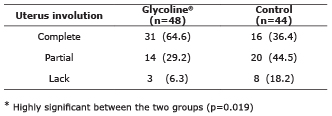
Genital conditions. All females who had reproductive tract infections before the postpartum examination or at the time of the examination were treated (Table 4).
Table 4. Distribution of the number (%) of cows in the Glycoline® and Control group according to the diagnosis of the genital tract condition 1-40 days postpartum.
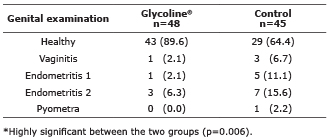
Ovarian pathologies. No LC were diagnosed in any of the cows in both groups and no FC were found in GG cows; however, 18.2% (8/44) of CG cows presented FC (p=0.002; Table 5).
Table 5. Distribution of the number of cows (%) in the Glycoline® and Control group according to ovarian activity (follicles, CH, CL), in the postpartum exam.
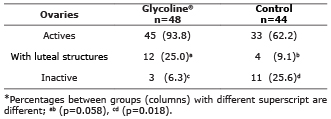
Postpartum estrus. The total number of cows in estrus (1-202 days) tended to be different between groups (GG, 91.8%; 45/49 and CG 76.0%; 38/50, p=0.091). Looked at from another point of view, 8.2% (4/49) of the GG cows and 24.0% (12/50) of CG cows showed no external signs of heat.
The average time (days) of estrus presentations were different between the GG (40.1±25.7; range: 7-145; IC: 32.5-47.7) and CG (63.5±44.9; range: 11-202 IC: 48.5-78.4; p=0.033, Table 6).
Table 6. Distribution of the number (%) of cows in the Glycoline® and Control group according to the interval of time from calving to first estrus in fixed and cumulative periods.
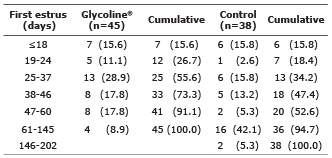
Inseminated cows. The number of inseminated cows was different between groups (GG, 79.6%; 39/49 and CG, 68.0%; 34/50, p=0.0176). Consequently, the number of cows that were not inseminated was 10 (20.4%, 4 that presented estrus 6 that did not) and GG 16 (32.0%, 4 presented estrus and 12 that did not) from the CG.
Conception services. Conception rates were not different between the GG (2.4) and CG (2.3).
Pregnancy rate. There was no difference, either in pregnancy rate at day 150, taking into account the total number of cows in the GG (57.1%; 28/49) and CG (46.0%; 23/50; p≥0.317) and only the number of cows inseminated between the GG (71.8%; 28/39) and CG (23/33 69.7%; p=1.00, Table 7).
Table 7. Distribution of the number (%) of pregnant cows in the Glycoline® and Control group in relation to the total number of inseminated cows in fixed and cumulative time periods.

Time intervals between calving to first heat, calving to first insemination and calving to pregnancy. These time intervals were analyzed retrospectively once all data were collected from both groups (Table 8).
Table 8. Time intervals (days) between calving to first heat, calving to first insemination and calving to conception of cows in the Glycoline® and Control groups.
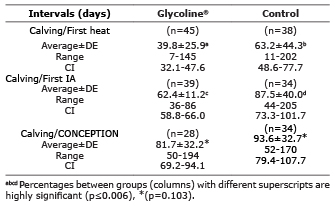
DISCUSSION
A cow from the GG was eliminated early due to death. Also, the total number of cows in each group varied as time went on because some were culled for various reasons (see text). In order to not delay the breeding program of the farm, all cattle that had any problems during the course of the study received special attention and specific treatments were applied according to the diagnosis.
Feed intake. Cows consuming Glycoline® slightly rejected feed on the first day. Feeding was normalized after the second day so this observation was suspended and was considered eager and similar to CG.
Abortions and offspring deaths. In GG there was 1 abortion (2.0%) and 2 dead calves (4.1%); but in the CG there were 2 abortions (4.0%) and 4 deaths (8.0%; Table 2). Despite overall losses (abortion and deaths) were twice in the CG (12.0%; 6/50) than in the GG (6.1%; 3/49), no differences were found (p=0.487). This rate of loss is within the range indicated by other authors (6.0-8.0%) for the GG but not for the CG, which were comparatively higher (7).
In both groups, abortions occurred in the ninth month of pregnancy and deaths occurred during or immediately after birth. The causes of the abortions were not attributed to reproductive diseases.
Calving difficulties and retained fetal membranes. It is interesting that no cow in the GG needed obstetric intervention during calving. They did not need manual or pharmacological medical treatment to remove the placenta. All cows in this group had placentas that came out without difficulty and were quickly expelled in less than 3 hours. In contrast, only 1 cow in the CG (2.0%) required minimum obstetric aid, while 12.0% (6/50) required manual intervention and pharmacological treatment (p=0.027). This percentage is within what other authors having reported, indicating that RMF occurs in the range of 3.8-15.0% of dairy cows (8).
It has been observed that RMF is a predisposing factor in metritis development and that postpartum metritis in cows with RMF has a negative effect on their subsequent reproductive efficiency (1,8,9). In this case, 50% (3/6) of cows from the CG that had RMF later developed metritis and this obviously delayed its return to the farm’s breeding program.
Presentation of metabolic diseases. Independent of what group they were in, all cows that showed apparent signs (presumptive, clinical or subclinical diagnosis) of metabolic disease were treated with one or more commercial compounds based on Ca, Mg, P and vitamins or with a neoglucogenic product. Glycoline® is routinely used to prevent ketosis. In this case, the number of cows that had fallen cow syndrome was 3 times higher in the CG than in the GG (22 vs. 7 cows respectively, p=0.002). The direct preventative effect of Glycoline® on “downer cow syndrome” had an indirect positive effect on the fertility of the cows that were treated with it.
Uterine involution. Despite being a subjective assessment through rectal exams, this parameter is important because it indirectly influences other reproductive variables, such as presentation of first postpartum heat, open days, etc. Certainly, delayed uterine involution further predisposes the presentation of metritis. The time of uterine involution in cows is variable and ranges from 25-45 days. When it occurs without interruption and within a reasonable time it has positive effects on other reproductive indices such as earlier estrus and a higher pregnancy rate, among others.
Considering combined uterine involution (total and partial), we observed that 93.8% (45/48) of the GG cows showed different degrees of uterine involution (Table 3). Of these 68.9% (31/45) had complete uterine involution and 31.1% (14/45) had partial involution In contrast, 80.0% (36/45) of CG cows showed some degree of uterine involution. Of these cows 44.4% (16/36) had complete uterine involution and 63.9% (20/36) partial (p=0.019) involution. This indicates that Glycoline® had an effect on uterine involution, which had a positive impact on the other variables studied. As indicated, uterine involution and follicular development are interrelated parameters that are involved in the rapid production recovery (10).
Genital affections. Cows that had some type of reproductive tract infection before or during postpartum examination were grouped together for data analysis.
It was observed that the percentage of cows that had metritis in the GG (10.4%; 5/48), was the 1/3 of those that had it in the CG (35.6%; 16/45; p=0.006). It has been indicated that 20% of dairy cows develop metritis within 21 days postpartum (9) which is twice that observed in the GG and 15% less than the CG.
Examination of ovaries, activity and pathologies. The number of cows that had postpartum anestrus was four times lower in GG (6.3%) than in the CG (25.0%; p = 0.019). This clearly indicates the positive effect of Glycoline® on cows fed with it. Considering just the total number of cows with ovarian activity, it can be seen that more than double the GG cows (26.7%; 12/45) had luteal structures compared to CG cows (12.1%; 4/33). However, this difference was greater when the total number of each group was taking, reaching a difference of almost 3 times (25.0% vs. 9.3%, p=0.056 respectively). It can therefore be inferred that Glycoline® had an early indirect effect on recovery of ovarian cyclicity, probably due to the more rapid recovery of the somatotropic axis, as has been mentioned by other authors (11, 12).
In the GG there was a cow that had 2 CL and another one had 3 CL while in the CG only cows with 1 CL were found. Multiple ovulation could be due to elevated milk production (3). Also, in recent years there has been a higher percentage of twins in Holstein cows. It has been hypothesized that high-producing cows have an increased intake of dry matter and therefore have a greater flow of blood to the intestines and liver, which would result in an increased amount of estrogen produced by the dominant follicle, which would alter the feedback (FSH) causing an increase of it, which would facilitate the development, maturation and ovulation of other follicles (8). Other authors have suggested that a glycogenic diet given in early postpartum would improve follicular development and resumption of the ovarian cycle, but for this to not have a detrimental effect on the embryonic survival rate it should be accompanied by a lypogenic diet given during the reproductive season in order to increase fatty acids, which improve the quality of oocytes and embryo development (13).
Glycoline® also had an effect in reducing the formation of ovarian cysts, as no FC and LC were diagnosed in GG cows. Nor was LC diagnosed in any of the CG cows. However, 18.2% (8/44) of the cows from this group had FC (p=0.002). Out of 8 cows treated with hormone therapy, 7 were in estrus and inseminated, which left 3 pregnant and 1 that did not present estrus (Table 5).
External signs of first postpartum estrus. Of the 4 cows that showed no estrus in the GG, 2 were diagnosed with downer cow syndrome, 1 had a substantial drop in milk production and the other had a sagging udder. Also, of the 12 cows that did not have estrus in the CG, 4 had downer cow syndrome and 1 had pyometra, 1 had metritis and hoof problems, 1 retained fetal membrane, 1 had follicular cysts, 3 had mastitis, 1 had a sharp decrease in milk production. These factors negatively influenced the presentation of estrus.
As noted, until day 60 (10 days after more the voluntary waiting period), 91.1% (41/45) of the GG cows were in estrus, compared to 52.6% (20/38) of the CG (Table 6). That is, only 4 (8.9%) cows of the total missing show estrus in the GG, unlike 18 (47.4%) missing it in the CG. In this regard, it has been indicated that between 15 and 20% of dairy cows are non-cycling before 70 days postpartum; this percentage contrasts with the findings in the CG. Also, in the GG a relatively uniform distribution of estrus is seen during the periods chosen than the distribution of CG. This indicates an obvious delay in reproduction of the latter group, which indirectly affected other variables (IA, time periods).
Showing estrus and efficiency in estrus detection are crucial factors for AI to occur at the appropriate time in relation to ovulation. With decreased estrus expression and the ability to detect it, it is difficult to perform AI at the right time. External presentation of signs of estrus indirectly impact in a positive way on other reproductive parameters, such as: the interval from calving to first AI, calving-conception etc., making reproduction more efficient and ultimately lowering operating costs (14).
Inseminated cows. The total number of inseminated cows was higher in the GG (79.6%, 39/49) than in the CG (68.0%, 34/50; p=0.0176). Of 10 cows that were not inseminated in the GG; 4 showed no estrus, as indicated above, and the remaining 6 that showed estrus were not inseminated due to different problems (2 had late anestrus, 1 had mastitis, 3 had downer cow syndrome) and were subsequently eliminated. In contrast, the number of cows in the CG that were not inseminated reached 32.0% (16/50), 12 did not show estrus and were eliminated and 4 showed signs of estrus but were not inseminated due to different causes (3 had downer cow syndrome, 1 retained fetal membranes and one had severe mastitis).
Calving to first estrus. In a study conducted in Japan where 38 high production Holstein cows (7) were used, results showed that, the first postpartum estrus was at 64.4±55.9 days (range 18-149 days), similar to that found in this study in the CG (63.2±44.3, range 11-202 days), and greater than the GG (39.8±25.9 range: 7-145 days, p=0.006). In the GG, cows were in estrus within a shorter period of time and in greater numbers than in the CG.
Calving to first IA. Those same authors (7) indicated that the time span from calving to first IA was 90.6±22.1 (minimum 57, maximum 129); period that was similar to that found for the CG (87.5±40.0), but higher than the GG (62.4±11.2; p=0.001).
Open days. The time difference in open days tended to be different between the GG (81.7±32.2) and CG (93.6±32.7, p=0.103). Both periods were lower than those reported by Japanese authors (7) who reported times of 151.3±55.8 and ranges from 66-270. In summary, this was observed in each analyzed interval of time, indicating the positive effect of Glycoline® on reproductive performance.
Services per conception. Services per conception were similar between the GG (2.4) and GC (2.5). Only 6 cows could be inseminated 3 times in each group due to high production; the other cows received a maximum of two inseminations.
Pregnancy rate. There was no difference in total pregnancy rate taking into consideration the total number cows (GG 57.1%, 28/49 and CG 46.0%, 23/50; p=0.317) or the total number inseminated (GG 71.8%; 28/39 and CG 67.6% 23/34, p=1.00). Analyzing this parameter individually could lead to mistakenly thinking that both groups are equal and that Glycoline® has no real positive effect on reproduction. That would be wrong and a misinterpretation of reproductive variables, since reproductive parameters, as indicated, should be analyzed together to determine whether or not there is a failure in a farm’s reproductive management and thus make adequate changes to improve. Considering the difference in the number of cows culled from each group, it was observed that the GG had 20.4% (10/49) of the cows removed as opposed to 32.0% (16/50) in the CG, which represents great economic loss for the farm.
As for periods of time, it can be indicated that up to day 70 postpartum, 41.0% (16/39) of the GG cows and only 17.6% (6/34) of CG were gestating (Table 7).
Analyzing the data and parameters together that were modified by the use of Glycoline® we can infer that in most of them, Glycoline® had a beneficial effect on the different parameters studied. Recent studies have reported relatively high reproductive performance in cows with a similar production (≥10.000Kg milk) when compared with lower production herds, possibly due to better nutritional and reproductive management (15).
Concerning this, in a study where, 16 prepartum Holstein Friesian cows were treated with a balanced cation/anion feed and minerals (GRB-CA) to support immune status during calving and prevent negative energy balance, only 21.0% of them had metritis, in contrast to 71.0% of the untreated group. Although these percentages were higher than those found in this study (GG: CG 10.4% vs. 35.6%), the proportion of cows with metritis (GG: CG=1: 3.1 vs. GRB-CA: CG=1: 3.5) were similar (6).
If factors that affect reproduction are not detected early, they will surely have a severe effect on the reproductive efficiency of cows and high milk production. In conclusion and according to the results, we can say that Glycoline® indirectly produced a beneficial effect on all reproductive variables.
Acknowledgements
To PRINAL SA, Santiago, Chile and AGQ SL, Madrid, Spain, for funding this study. To Dr. Mario E. Mosqueira and Dr. Claudio A. Parada for their contributions and suggestions during the course of this study, and Ms. Sandra L. Fernandez for her work with data processing.
REFERENCES
1. Walsh SW, Williams EJ, Evans ACO. A review of the causes of poor fertility in high milk producing dairy cows. Anim Reprod Sci 2011; 123:128-138.
2. Osumo O, Kabeya S, Koyama H. Factors affecting reproductive performance in high milk-producing Holstein cows. J Reprod Develop 2010; 56:561-565.
3. Wiltbank MC, Souza AH, Carvahlo PD, Bender RW, Nascimento AB. Improving fertility to timed artificial insemination by manipulating of circulating progesterone concentrations in lactating dairy cattle. Anim Reprod 2012; 24(1):238-243.
4. Mulligan FJ, Dohert ML. Production diseases of the transition cow. Vet J 2008; 176:3-9.
5. Roche JF. The effect of nutritional management of the dairy cow on reproductive efficiency. Anim Reprod Sci 2006; 96:282-296.
6. Mikko A. Monitoring of transition period feeding improves health. Intern. Dairy Topics 2012; 11:25-27.
7. Murray RD, Williams AJ, Shelton IM. Field investigation of perinatal mortality in Friesian cattle with myocardial degeneration and necrosis. Reprod Domest Anim 2008; 43:339-345.
8. Leblanc SJ. Postpartum uterine disease and dairy herd reproductive performance; A review. Vet J 2008; 176:102-114.
9. Shelton IM, Cronin J, Goetze L, Donofrio G, Schuberth HJ. Defining postpartum uterine disease and the mechanisms of infection and immunity in the female reproductive tract in cattle. Biol Reprod 2009; 81:1025-1032.
10. Ruiz JL, Uribe-Velásquez LF, Osorio JH. Factor de crecimiento semejante a insulina tipo (IGF-1) en la reproducción de la hembra bovina. Vet Zootec 2011:568-81.
11. Lucy MC. Functional differences in the growth hormone and insulin-like growth factor axis in cattle and pigs: implications for post-partum nutrition and reproduction. Reprod Domest Anim 2008; 43 (Supl 2):31-39.
12. Thatcher W, Santos J, Silvestre F, Kim I, Staples C. Perspective on Physiological/endocrine and nutritional factors influencing fertility in post-partum dairy cows. Reprod Domestic Anim. 2008; 45:2-14.
13. Garnsworthy PC, Fouladi-Nashta AA, Mann GE, Sinclair KD, Webb R. Effect of dietary-induced changes in plasma insulin concentrations during the early post partum period on pregnancy rate in dairy cows. Reproduction 2009;137:759-768.
14. Roeloffs J, Lopez-Gatius F, Hunter RHF, van Eerdenburg FJCM, Hanzen C. When is a cows in estrus? Clinical and practical aspects. Theriogenology 2010;74:327-344.
15. LeBlanc SJ. Assessing the association of the level of milk production with reproductive performance in dairy cattle. J Reprod Dev 2010; 56 Suppl. S1-S7.